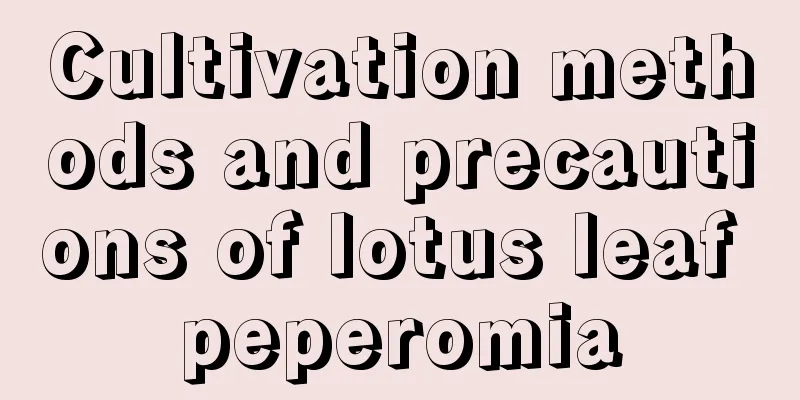Cultivation methods and precautions of lotus leaf peperomia

Distribution and growth habits of Peperomia paniculataDistributionThe origin of Peperomia paniculata is Brazil, and it is mostly distributed in tropical and subtropical regions. Growth habitSince Peperomia paniculata is mostly distributed in tropical and subtropical regions, it prefers a high temperature and high humidity growing environment. It is not cold-resistant or drought-resistant. It requires sufficient light, preferably scattered light, and avoids strong light. How to cultivate lotus leaf peperomiaLight and temperaturePeperomia requires sufficient diffuse light, and it is best to avoid direct sunlight during its growth period. It is also very shade-tolerant and needs to be shaded when the sun is strong in the summer. In terms of temperature, the suitable temperature for the growth of Peperomia japonica should be kept between 20℃ and 30℃. It is not cold-resistant and needs to be kept warm in winter. It is best not to be lower than 5℃, otherwise frost damage will occur. In summer, the temperature should not exceed 35℃. Provide appropriate shade and increase ventilation to lower the temperature. soilPeperomia has high requirements for soil, which must be fertile and well-drained. Generally, when planting peperomia, you can choose sandy soil. When planting in pots, you can use a mixture of several media, such as peat soil, leaf mold, perlite, etc., mixed in a certain proportion. Watering and fertilizingThe lotus leaf peperomia does not require high humidity, but moist is best. During the growing period of Peperomia japonica, the soil in the pot needs to be kept moist and watered once a day. If the weather is dry, you can spray water on the leaves. However, be careful not to make the soil too wet to avoid root rot. Fertilization can be applied once or twice a month. To make the leaves green and beautiful, you can apply more nitrogen fertilizer. Precautions for the cultivation of lotus leaf peperomiaReproduction methodThe propagation of Peperomia paniculata mainly involves division and leaf cuttings. Division propagation can be carried out in spring and autumn, and leaf cuttings can be carried out from May to June. DiseasesDuring the growth period of Peperomia japonica, it is important to pay attention to root rot and stem rot caused by overly wet soil in the pot, and anthracnose caused by overly humid air. The growing environment needs to be kept ventilated and treated with pesticide spraying. Other considerationsIn rainy weather, good drainage is needed to avoid excessive rain and excessive wetting of the soil in the pot, which will lead to root and stem rot. It is important to control the light. Too strong light will burn the leaves and fade the color, while excessive shading will cause the plant to grow too tall and fall over, making it lose its ornamental value.
|
<<: Cultivation methods and precautions of black heart chrysanthemum
>>: Cultivation methods and precautions of Pteris fasciata
Recommend
How to cultivate Tillandsia to make it more vigorous
Tillandsia growing conditions Tillandsia prefers ...
The reason why the trunk of the peace tree turns black
1. Infection It may be due to the influence of hu...
How to raise Wanchongshan
Habits One of the habits of Wanchongshan is to lo...
Banyan bonsai maintenance and management
Maintenance points Generally, banyan bonsai shoul...
What to do if the lotus leaves turn black and rot
reason Overfertilization Too much fertilizer will...
How to plant purple peony seeds
Obtaining seeds The fruit of the purple peony mat...
How many kilograms of grapes are produced per acre
Grape yield per acre If the grapes are properly m...
Is Clivia harmful to the human body?
Release oxygen Clivia prefers a semi-sun and semi...
How to plant purple-leaf barberry seeds
1. Sowing time The sowing time will vary dependin...
Cultivation methods and maintenance of old rose piles
How to grow roses into old piles Rose is a plant ...
How long does it take for blue snowflake cuttings to take root and when is the best time to do it?
Rooting time of blue snow flower cuttings The bes...
How to grow potted jade plants and what to do if they get sick
1. How to raise 1. Sunlight: Usually keep it in a...
Cultivation and shaping techniques of bonsai of old persimmon
1. Seed propagation After the fifteenth day of th...
Three key points after flower seeds emerge
Light after seed germination After the flowers ar...
Cultivation methods and maintenance matters of old Trumpet Creeper piles
How to grow trumpet creeper into an old pile Trum...









